Burdock
When it’s difficult to focus and get started on a post, sometimes it helps to dig. We’re talking about mud, not information, (because it’s information overload that causes a writing clot). So, your’s truly, weedom1, hand dug a mini-burdock weed that had invaded the garden. This took a good long while since the roots of even the small plants are deep, while a large wild burdock sends its branched roots halfway to China.

No one gets all the way to the tips of full size burdock roots while hand harvesting. Too much pain, effort and breakage. So that’s why the cultivated forms of burdock, such as the famous Takinogawa are planted in loose soil if possible. In agricultural scale production, modified root harvesting equipment is used to go extra deep and get enough of the roots to be worthwhile. Up to half of the root length may be left behind during mechanized harvesting. Some gardeners plant their special pedigreed plants close together in deep boxes of loose soil, and obtain some remarkably slender and straight roots. Manually digging quantities of wild burdock, which happens around frost time or later, is a whole different process involving a fair amount of exertion, possibly accompanied by some colorful language. Frequently you can’t use the upper part of larger roots, (particularly for eating) because that part is more woody or hollow. The quality improves as you go deeper. This manual labor in herbalism is comparable to the winter training or testing procedures for martial artists. Try it for an afternoon or so, and you’ll appreciate the people who dig up large quantities of this plant for the Japanese health food (gobo).
Burdock, (Arctium species) is both food and medicine, or nutraceutical. There are numerous species in this genus, but the two main ones we can encounter in Midwest flyover country are Arctium lappa, which is the most recognized Asian food and medicine species, and Arctium minus, which is very similar, more plentiful here, and can be used interchangeably. What inspires the trouble of harvesting burdock is the deep nutrition, minerals, vitamins, phenolic compounds, oils, demulcents, and inulin found throughout this plant. The truly edible portions are the roots, and the early interior stems of the second year growth. Seeds are considered more acutely medicinal, while the roots are considered a milder acting food/medicine for chronic use, whether as a food or in an infusion. Chinese medicine uses burdock seed as an acute treatment for sore throats, swelling, hives, mouth sores, as a diaphoretic, and as a kidney yin tonic. Leaves are used topically for wound and rash care, but are very bitter, and not generally favored for eating. The very young leaves are sometimes consumed, however. Burdock is considered an alterative, or restorative, most particularly to the bodily detoxifying systems: the liver and the kidneys, but also contributes to the health of the gut. Note that while burdock roots are overall quite safe, the seeds should particularly be avoided by pregnant women.

Our 2 burdock species of interest usually have biennial lifecycles, although this can be longer in certain circumstances. It exists as a rosette in the first year, although this stage can persist a second year. In the last year of life, multiple flowering stems shoot up to a height reaching from 1 to 3 meters, (3 to 9 feet) depending on species and environment. Arctium lappa tends to grow a bit taller with proportionately more slender stems. If grown side by side, Arctium lappa tends to bloom a couple weeks sooner than Arctium minus.
We have no blooming pics this year, due to drought and mowing, however you can see some flowers and seed carrying burrs of each species linked here and here. Flowering heads, with purple tubular disc flowers in flat topped clusters, appear during summer or fall at leaf axils and the tips of flowering stems. Those of Arctium lappa tend to be larger, 1-3 inches, in larger groups with each bloom on a longer pedicel (flower stem). while those of Arctium minus are 1 inch or less, in tighter clusters with each flowering head on a shorter pedicel. Flowering heads are thistle-like, with a green base of spiky bracts supporting the 20 to 40 disk flowers. Later the bracts enclose the flowers, and turn brown, becoming the famous clingy burr that travels on any passing animal, spreading seeds everywhere. This hitchhiking nature of the the burrs accounts for the accidental spread of these plants from Asia to Europe , the U.S. and elsewhere.
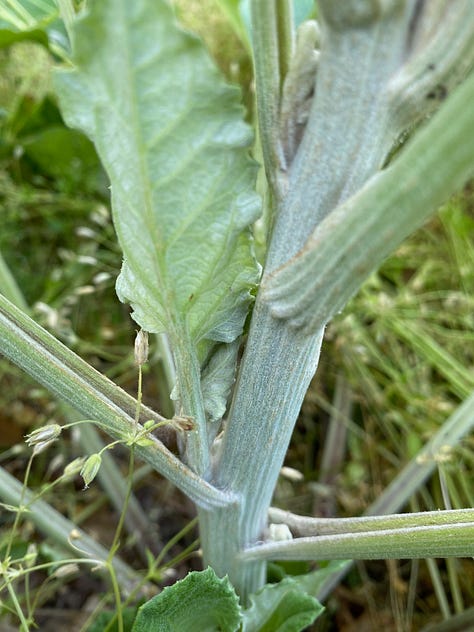
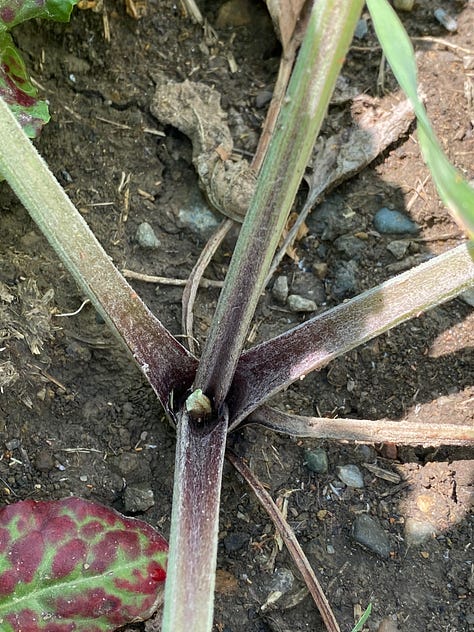
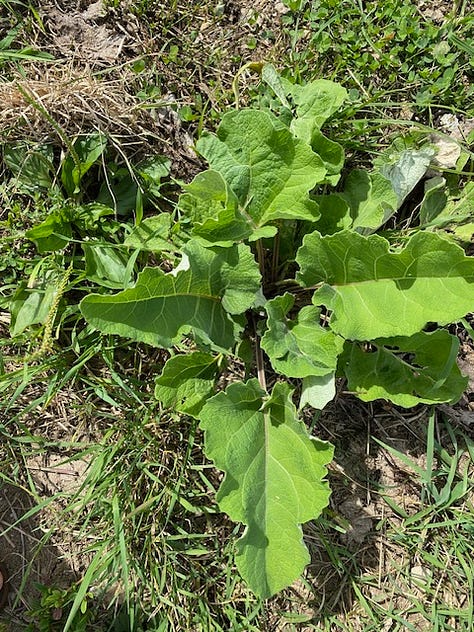
Basal leaves of burdock are huge, 60 cm, (2 feet) long and half as wide. heart shaped, with wavy edges, somewhat irregular margins with sparser hairs above, and copious short hairs below. Leaves of A. minus tend to be a little thicker, wavier, while those of A. lappa are a little smoother edged, and a little more silvery underneath. The leaf petioles of the basal leaves of A. minus are persistently hollow, while those of A. lappa are not. Leaf petioles and stems of both species are hairy, and most often have magenta or purple tint.
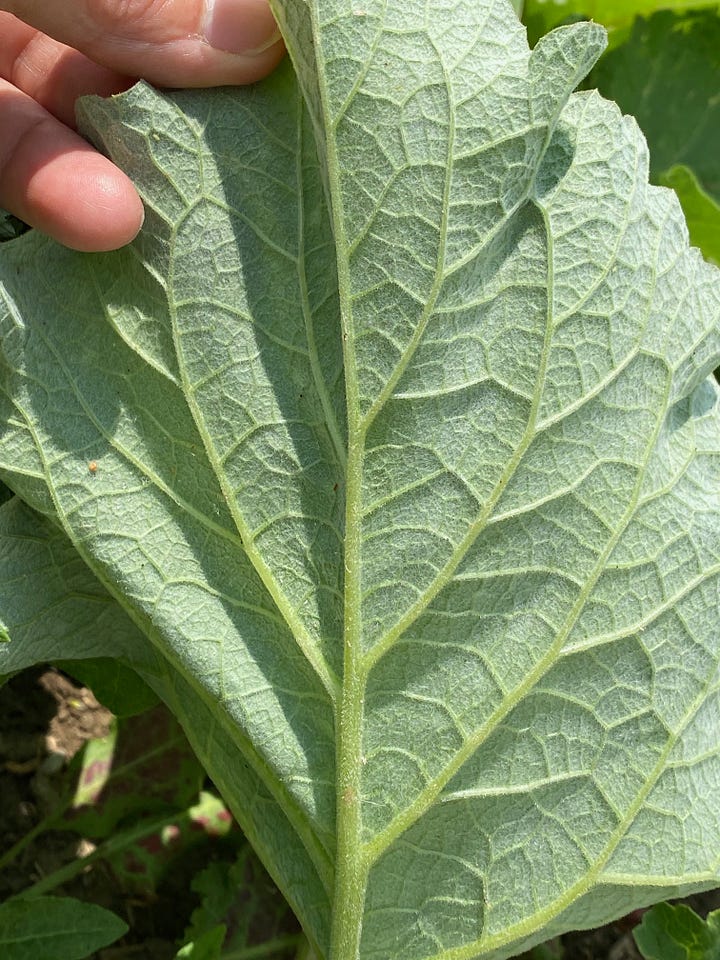
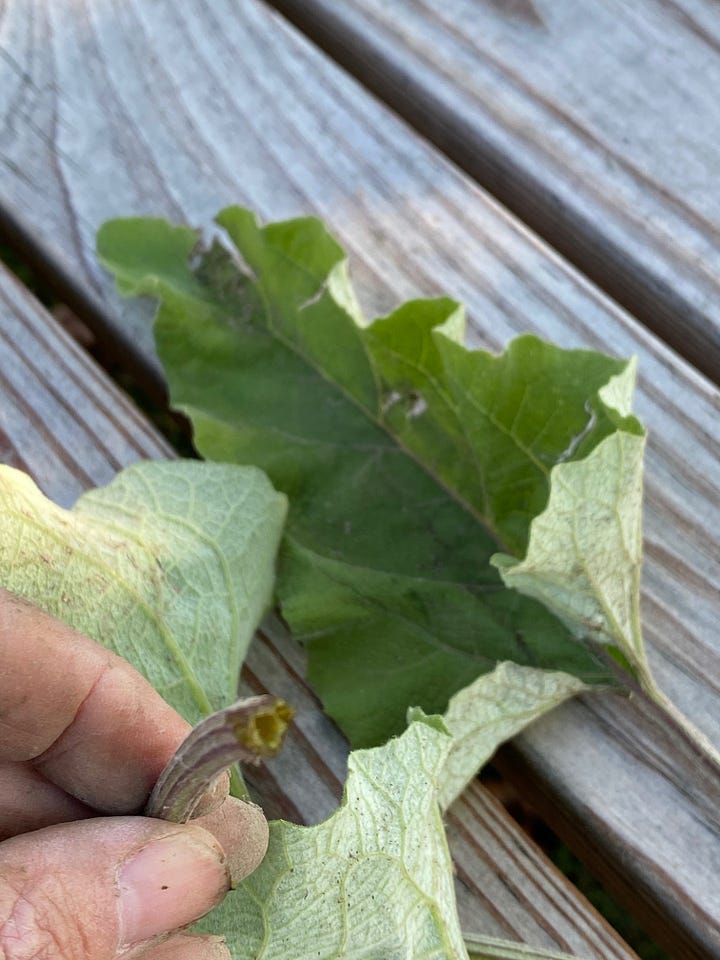
A couple of inedible look-alikes to avoid when foraging for wild burdock are skunk cabbage, which normally lives in wetter, swampier soil, and wild rhubarb, which grows under similar conditions as our weed of choice. The leaf petioles of the very early blooming skunk cabbage are green, and the leaves are shiny, while leaf petioles of wild rhubarb have some magenta to red coloration as does burdock. Rhubarb leaves’ upper surfaces are shiny, and they are hairless above and below, while the burdock leaves are not shiny, and have many fine hairs above, and even more below.
Getting back to our roots, the best tasting ones come from younger or smaller plants, and tend to be an inch and a half or less in diameter. The dried roots may be composed of up to 50 percent inulin, which is a complex carbohydrate mixture of fructan chains of varying lengths. Inulin is insoluble fiber which serves as a prebiotic. Though humans cannot digest this substance, it is fermented by the flora of the gut and serves as their source of nutrition. 20 grams or so of inulin itself can serve to maintain beneficial gut flora. There can always be too much of a good thing, and you’ll know by the orchestral sounds and fury of intestinal gas if you’ve overdone your burdock consumption. The roots also contain a good deal of minerals, which it drags up from deep in the soil. They also contain an array of micronutrients and vitamins including ascorbic acid and …. umami flavor, (which is attributed to the presence of glutamates).
Those people prone to skin rashes, eczema, psoriasis, and acne might want to include burdock root in the diet or as a supplement or tea. In general, supporting good health and nutrition for the liver and kidneys can help skin problems. It can even help with such things as joint pain, and allergies. A well nourished body will more efficiently clear itself of toxins and irritants. If you can’t dig your own burdock, check out an Asian grocery store. Scrub your roots well, and scrape off the unwanted bits of outer skin with a knife. Using a peeler might waste too much of the beneficial components. The cleaned roots can be sliced in cross section, or julienne style and soaked in a bit of vinegar or lemon juice mixed with water so they don’t turn brown while your cut up your other vegetables, such as carrots, etc. You can cook some chopped fresh ginger in oil, add the burdock, carrots, onions and other vegetables in order of their needed cook time, and stir fry them together. Add a little tamari sauce or soy sauce, mirin or sake, put a lid on the pan, simmer the mix for a few minutes, throw in some sesame seeds and/or a little sesame oil, and serve the veggies immediately.
Tincturing fresh (finely chopped) burdock root in 50 percent (or higher) ethanol will produce a dark brown liquid with a thick layer of white precipitate. That precipitated material is mainly comprised of inulin which is insoluble. Shake up your tincture before dispensing, to disperse the inulin if you want all the benefits. If you choose to dry your burdock root for tea, remember to chop it up first. This root will get really hard once it has dried. When making the tea consider cold infusion, or not using boiling water, since this may change the texture of the mucilaginous, demulcent compounds.
We’ve only scratched the surface of the benefits of burdock. Research turns up more of its constituents and uses all the time, so we’ll need to return to this herb and how it can be used for your good nutrition and health. Till then, consider trying out some recipes, and making burdock root a part of your diet.
Where We Dig
1. Wu KC, Weng HK, Hsu YS, Huang PJ, Wang YK. Aqueous extract of Arctium lappa L. root (burdock) enhances chondrogenesis in human bone marrow-derived mesenchymal stem cells. BMC Complement Med Ther. 2020;20(1):364. doi:10.1186/s12906-020-03158-1
2. Arctium lappa (Bardane, Beggar’s Buttons, Burrdock, Edible Burdock, Gobo, Great Burdock, Greater Burdock, Lappa, Snake’s Rhubarb, Thorny Burr) | North Carolina Extension Gardener Plant Toolbox. Accessed October 11, 2023. https://plants.ces.ncsu.edu/plants/arctium-lappa/
3. Arctium minus (Bardane, Common Burdock, Lesser Burdock) | North Carolina Extension Gardener Plant Toolbox. Accessed October 11, 2023. https://plants.ces.ncsu.edu/plants/arctium-minus/
4. Arctium minus (Common Burdock): Minnesota Wildflowers. Accessed October 11, 2023. https://www.minnesotawildflowers.info/flower/common-burdock
5. Wang D, Bădărau AS, Swamy MK, et al. Arctium Species Secondary Metabolites Chemodiversity and Bioactivities. Frontiers in Plant Science. 2019;10. Accessed September 26, 2023. https://www.frontiersin.org/articles/10.3389/fpls.2019.00834
6. Liu C, Yuan P, Wang Y, et al. Effects of burdock inulin-type fructans exposure on the physiological function of healthy mice and their filial generation. J Vet Med Sci. 2023;85(4):425-433. doi:10.1292/jvms.22-0530
7. Maier K, Gladstar R. Energetic Herbalism - A Guide to Sacred Plant Traditions Integrating Elements of Vitalism, Ayurveda, and Chinese Medicine. Chelsea Green Publishing; 2021. https://openlibrary.org/books/OL34171771M/Energetic_Herbalism
8. Sheng W, Ji G, Zhang L. Immunomodulatory effects of inulin and its intestinal metabolites. Front Immunol. 2023;14:1224092. doi:10.3389/fimmu.2023.1224092
9. Hoffmann D. Medical Herbalism: The Science and Practice of Herbal Medicine. Healing Arts Press; 2003.
10. Gao Q, Yang M, Zuo Z. Overview of the anti-inflammatory effects, pharmacokinetic properties and clinical efficacies of arctigenin and arctiin from Arctium lappa L. Acta Pharmacol Sin. 2018;39(5):787-801. doi:10.1038/aps.2018.32
11. İlgün S, Karatoprak GŞ, Polat DÇ, et al. Phytochemical Composition and Biological Activities of Arctium minus (Hill) Bernh.: A Potential Candidate as Antioxidant, Enzyme Inhibitor, and Cytotoxic Agent. Antioxidants (Basel). 2022;11(10):1852. doi:10.3390/antiox11101852
12. DerMarderosian A, Buetler J. Review of Natural Products. 8th edition. Lippincott Williams & Wilkins; Facts and Comparisons; 2014. https://openlibrary.org/books/OL27960482M/Review_of_Natural_Products
13. Wood M. The Book of Herbal Wisdom - Using Plants as Medicine. North Atlantic Books; Distributed to the trade by Publishers Group West; 1997. https://openlibrary.org/books/OL1009748M/The_book_of_herbal_wisdom
14. Wood M. The Earthwise Herbal - A Complete Guide to Old World Medicinal Plants. North Atlantic Books; 2008. https://openlibrary.org/books/OL12031143M/The_Earthwise_Herbal
15. Amish Burn Study Group, Kolacz NM, Jaroch MT, Bear ML, Hess RF. The effect of Burns & Wounds (B&W)/burdock leaf therapy on burn-injured Amish patients: a pilot study measuring pain levels, infection rates, and healing times. J Holist Nurs. 2014;32(4):327-340. doi:10.1177/0898010114525683
16. Thayer S. The Forager’s Harvest - A Guide to Identifying, Harvesting, and Preparing Edible Wild Plants. Forager’s Harvest Press; 2006. https://openlibrary.org/books/OL8588402M/The_Forager's_Harvest



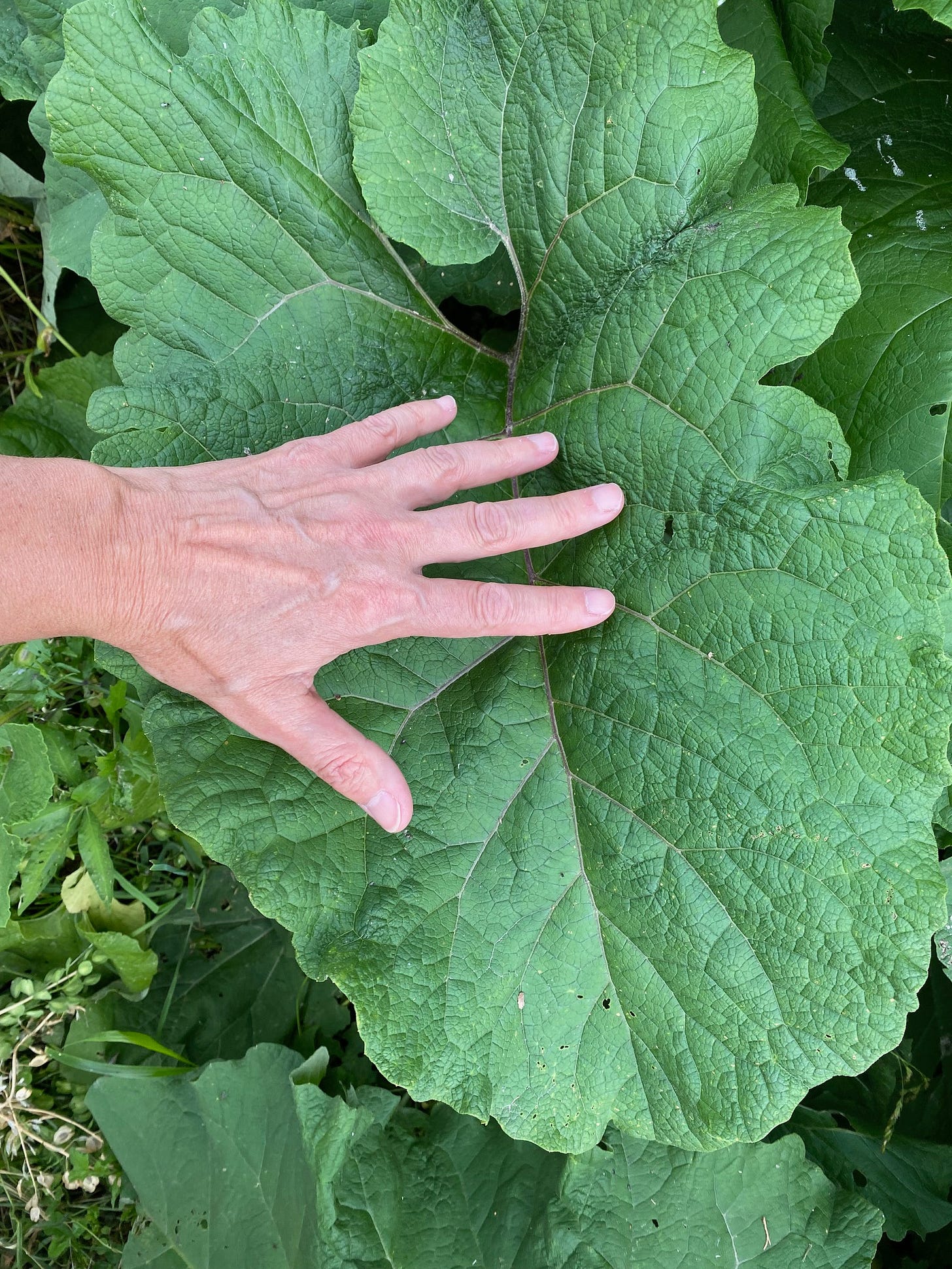



Bees love the flowers. An added benefit, especially for beekeepers.
This is one of my fav root vegetables; very common side-dish in Korea. I've never found burdock in Aus, though!